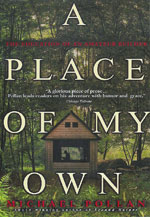 1998 edition | |
| Author | Michael Pollan |
|---|---|
| Language | English |
| Publisher | The Penguin Press |
Publication date | 1997, 2008 |
| Media type | |
| Pages | 320 |
| ISBN | 0143114743 |
| Preceded by | Second Nature (book) |
| Followed by | The Botany of Desire |
A Place of My Own: The Education of an Amateur Builder was Michael Pollan's second book, after Second Nature: A Gardener's Education (1991). In 2008, it was re-released and re-titled as A Place of My Own: The Architecture of Daydreams.
The book begins by outlining how Pollan reached the decision to build a "writer's house" himself. The second chapter covers the site selection process. The next chapter follows the design process, including references to Christopher Alexander's A Pattern Language . The following four chapters deal with the construction process. The final chapter covers the finishing work and moving in.
The book is not a how-to book for first-time builders. It is a general overview of the building process, the experiences involved, and the motivations of the author.